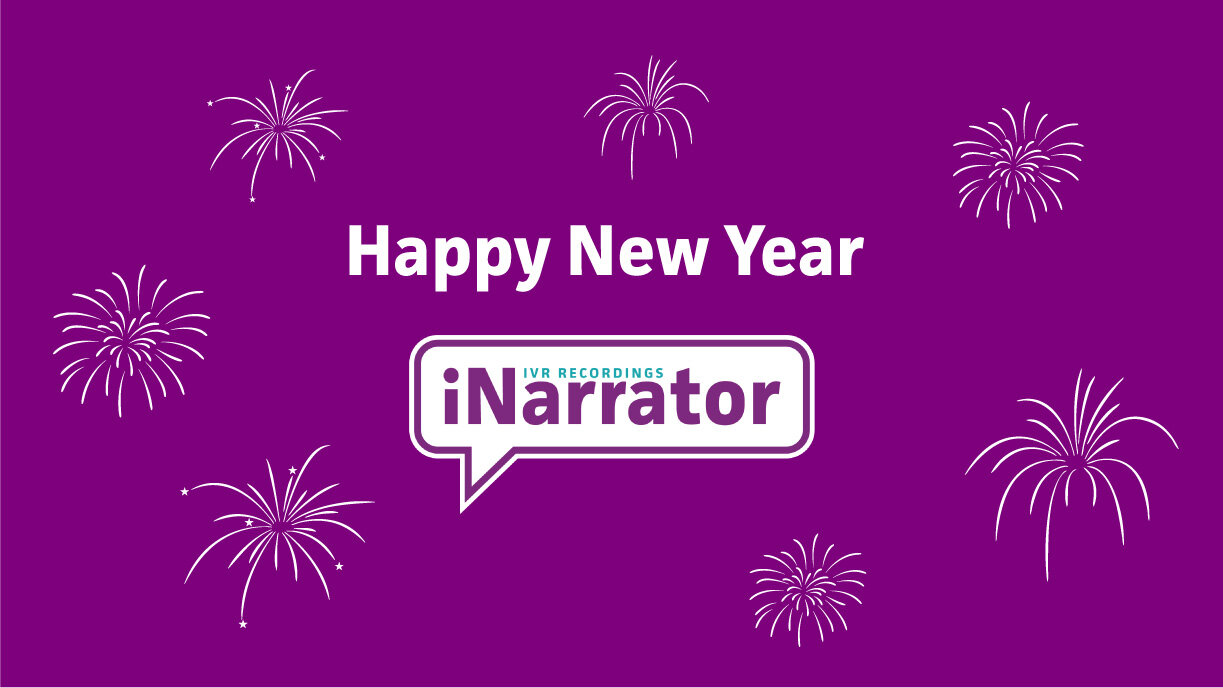What Is an IVR Message?
Simply put an IVR Message is the voice prompts you’ll hear when contacting a call centre.
An IVR Message will welcome you, tell you about the companies privacy policy and then usually give you a list of department options to choose from.
IVR Messages can be recorded in a number of ways:
By a company employee - a cheap option but due to poor sound quality the customer expereince can be negatively impacted.
By a professional voiceover artist - this presents the most authentic and engaging message, providing the best customer experience and showing your callers you care
AI Voice prompts - are quick and easy to implement but with a limited number of voice options and a lack of empathy this too can impact your customer experience.
Staying on top of call volumes can feel like an uphill battle for many organisations. Managing expectations, routing callers to the right place, and saving everyone time and hassle when they get there; without an Interactive Voice Response (IVR) system, this would be near impossible.
Over the years, IVR menus have evolved from embryonic ‘phone trees’ to become a sophisticated solution for call centres and large organisations. IVR messaging allows you to interact with callers, exchanging information to get them to the right place.
How does IVR Voice Messaging work?
Most companies have some form of IVR, ranging from a simple response menu to intelligent automated systems. Whether you’ve got something in place or not, it’s worth investing in IVR Voice Messages that deliver a smooth and efficient customer journey.
By working with an IVR consultant, like us, you can map out the ‘branches’ of your IVR tree, ensure that the scripts have the right tone of voice, and that your IVR recordings are in line with the rest of your brand.
Whether you’re starting from scratch or you want to step up the capabilities of your existing system, we can help. Our service can be tailored to your specific needs and deadlines, with a dedicated manager to oversee the project.
Audio Examples
Before working with IVR Recordings this is how Wandle sounded…
After working with IVR Recordings this is how good Wandle sounds…
Listen to our voiceover library here.
Curious to see what IVR messaging could do for your business?
To discuss your project, call our friendly team on 0161 850 3033 or email your script to
hello@ivr-recordings.co.uk for a free quote & audio demo.
Call & Contact Centre Expo November 2023
Yesterday I took a trip to the big smoke for the annual Call & Contact Centre expo at Excel, here are my thoughts on day one of the show…
The hot topic on every stand and in every seminar is… you guessed it AI
Everyone is talking about how AI and Generative AI (there is a difference) is currently revolutionising the customer experience and providing massive productivity gains to contact centres who embrace this new technology.
Looking at this AI hype from my sceptical point of view I feel it’s a case of keeping up with the Jones’… head of contact centres or procurement manager looking for a new CCAS solution are likely to want some AI ‘type’ functionality if not on day one certainly in the not to distant future, so every big player in the industry (8x8, TalkDesk, Nice, RingCentral etc) HAVE to offer AI just to be considered.
I wonder if businesses are paying for something (AI) they’ll never or very rarely make use of. There’s no doubt that AI is evolving faster than ever so who knows what will be available in 2 years time?
Across all the keynotes I attended there were two common themes:
Human to human voice conversation is here to stay – it’s still the most efficient way to assist customers with complex enquiries and vulnerable customers.
In most cases the benefits of rolling out AI sit with the contact centres (cost reduction, contact deflection etc) and not with customers. Sometimes the use of AI improves the customer experience but it has to be implemented in the right way.
Kylie from Poly AI put it best…
“It’s not about tricking people into thinking they’re talking to a person.
“It’s about enabling people to forget they’re talking to a robot.”
The award for most entertaining and interactive presentation at the expo goes to Martin Teesdale from Get Out of Wrap.






IVR System Horror Show - Are you guilty?
What horrors are lurking in your contact centre IVR?
Take a minute to pick up your mobile…
Dial your main IVR number and just listen…
Is your welcome message a ghastly greeting?
Does the voice sound like it’s been recorded in a Transylvanian castle by Dracula?
Does your GDPR message last an eternity?
Are your menu options sending callers batty?
Would it be more fun wading through a quagmire than listening to your call queue music?
Are your in-queue messages more repetitive than a werewolf’s howl?
Enough with the Halloween banter…
Transforming your IVR experience
If you need to improve your caller experience then we’re here to help; give us a call on 0800 852 7720 or request a call back
One way to manage higher call volumes is to improve your IVR experience to give callers the right information at the right time and allow them to self serve when relevant.
We’ve helped transform hundreds of call centre IVRs…
Take a look at our latest Case Studies or give us a call on 0800 852 7720
National Customer Service Week 2023
It’s National Customer Service Week…
The theme today is… ‘The Future of AI’
There’s a lot of talk in the contact centre industry about AI and how it’s going to revolutionise the customer experience and I’ve no doubt that AI has its place, but in my experience current systems using AI take a long time to train, deploy and manage once they’re live.
And on a handful of projects utilising AI, the client has actually rolled back to a previous system due to customer feedback.
What is your organisation doing to track and improve your customer service levels?
What’s your experience of deploying AI based systems?
The History of the Contact Centre - Part 2
The Emergence of the Call Centre
"More people have worked in call centres than ever worked in the mining industry”.
Matt Thorne, writer of Eight Minutes Idle shares this crazy statistic along with his experiences from working (and living) in a call centre.
Today around 4% of the UK’s workforce is employed by one of the UK’s 6000+ contact centres, and we’ve certainly seen a boom in business during lockdown. But how did the call centres of the late 80s develop to what we would describe as today’s modern day contact centre?
What do we have unlimited access to today which was only in its infancy in the 90s? The Internet!
It’s strange to think of a time when we didn’t have easy access to the internet. Imagine not having the ability to jump on a zoom meeting or buy something online.
Cast your mind back thirty years or so and the internet was slowly starting to be utilised by businesses who began to reap the benefits of the ease in increased communication and connectivity.
Technology In The Call Centre
In the late 80s big companies benefited from the technological advancements in ACDs (Automatic Call Distributor wiki) which allowed for automated exchanges and call routing, where callers listen to a voice recording then selected the department they would like to speak to, this was the beginning of the IVR system. The internet and call centre technology paved the way for companies to focus their entire business models on using contact centres as a way to do business.
The UK’s telecoms industry became deregulated in 1984 and this was a pivotal moment in creating a competitive telecommunications industry which was no longer dominated by monopolies, resulting in service costs dropping.
Deregulation encouraged new players to enter the market, increasing competition and resulting in the UK’s contact centre industry growing bigger than any other country aside from the USA.
By 1985, Direct Line was founded and became the first company to utilise the contact centre by selling insurance solely by phone. They stared with a team of just 63 and one contact centre and have paved the way in terms of customer centric and satisfaction led services.
Outsourcing & Off-shoring
Over the following couple of years, big name companies began to set up contact centres as a means to save money, with some outsourcing their needs to overseas call centres like entrepreneur Pramod Bhasin’s. This early adoption of a “quantity over quality” approach has led to some call centres becoming criticised for their operations and their approach to customer service.
As the factories and coal industry in the 1990s began to decline, the call centre was starting to boom, with Northern England and Wales being prime locations for new businesses to set up, piggybacking on the high unemployment rates.
This level of growth in the call centre allowed for many reasonably inexperienced people to gain employment which could be seen as a positive but led to an unhealthy working environment and culture. At this time, call centres used a script-based and unsolicited outbound calling approach. This resulted in customer dissatisfaction, high employment turnover rates and public perception of the contact centre was poor.
The running of early contact centres has been compared to the working environment of an industrial factory floor, with high quotas and little time for a personalised approach. Outsourced, offshore call centres, cost cutting and strained customer relations were rife by the end of the century. So, as the millennium approached, how could the call centre recover from such a tainted perception?
Turn of the century
We’ll be reviewing the contact centres of from the early 2000s to today’s in our next piece to highlight some of the major changes which have occurred in terms of operations, technology and most notably in call centre culture over the last few decades.
If you’ve not yet read part 1 in the series click here
The History of the Contact Centre
Love them or hate them, the contact centre is an institution from which we have been able to learn a great deal about our customers, shaping how we provide customer service as well as the products and services we supply.
The truth is call centres, or contact centres as they’re more commonly referred to now, often get a bad rap, with recent research from Whistl discovering that a bad call centre experience could see a business loose half their customers.
As time and technology have moved on, so to have attitudes to call centres but that’s not to say there aren’t still challenges faced by contact agents, we’ll explore this further on in the series.
The End of an Era
From manual switchboard-based telephone exchanges in the 1960s to the automated, voice activated phonelines of the modern day, telecommunication has come a long way over the years.
With advancements in technology, direct dialling and push-button phones pathed the way for a revolution in communication, with the seventies marking a pivotal point in the history of not only the call centre, but customer service.
In the UK, the last manual exchange switched to automatic dialling in 1976 and an International Subscriber Dialling System was introduced, meaning people could call both within the UK and abroad without the assistance of an operator.
Call centres were starting to emerge on a small scale, with companies such as Birmingham Press and Mail.
New technology – New techniques
The end of the switchboard era would mark the introduction of ‘toll free’ numbers and new technology which allowed businesses to adopt new sales techniques and using offices equipped to handle large volumes of incoming and outgoing calls, creating what we know today as call centres.
Call centres used PBX (Private Automated Business Exchanges) and offices were designed with rows and rows of agents and utilised Automatic Call Distributor technology, which simply put, answers incoming calls and automatically directs them to a specific department, much like the purpose of an IVR menu.
Big name businesses from British Gas to Barclaycard were among the first large corporations to embrace ACD technology to scale up their sales and customer service efforts. By 1972, the ten millionth telephone exchange line was installed in the UK as the use of the phone became more and more integral to businesses, just three years later that figure had doubled.
Outsourcing to Overseas
As business boomed, many businesses opted to look overseas to outsource their call centre operations and take advantage of lowering their operating costs. However, this came at the detriment of customer service, with public perception indicating that overseas agents were not as capable of dealing with their enquiries.
The call centre would soon become a new and vital component for UK businesses, completing changing the face of customer service. Companies embraced this new approach to sales and customer service, revolutionising the way we shopped, complained, received updates and more.
100 Years in the Making
1976 marked the centenary of the telephone. It’s strange to imagine that 100 years prior, the phone hadn’t fully been invented and yet 100 years on it was a part of daily life. People could now book plane tickets, make hotel reservations and speak with their bank, much more directly and efficiently than had ever been possible before.
Over the next 20 or so years, there’s many further advancements in technology and the relaxation of regulations on the UK telecoms industry help continue to improve the functionality and services a call centre can provide, with the 80s and 90s seeing a real boom in companies utilising operators and agents to grow their businesses.
No Signs of Slowing
The increase in demand for information dependant industries spurred on the growth of the call centre, and whilst the modern day call centre is a little more refined in its operations, it remains as one of the largest and rapidly growing sectors in the world.
Today there are over 6,000 contact centres across the UK, employing almost 800,000 people. From technical assistance to market research, bookings or emergencies, there’s not an industry in existence that doesn’t benefit from having someone on the end of the phone for their customers or clients to speak with.
An Agile Industry
We’ve seen all industries face challenges recently, adapting how to provide exceptional customer service at a time when companies have experienced huge disruption to their usual operations yet the contact centre has proved how agile it can be.
Adapting to new surroundings, working methods and technology to ensure businesses still functioned and customers were still updated and satisfied, the contact centre industry continues to flourish.
If you’ve recently experienced changes to the way your agents handle calls, then speak with us about our consultative customer experience services or our IVR options to ensure your customers stay happy and informed.
Easter Egg Hunt 2021
Easter is just around the corner which can mean only one thing…
The iNarrator Easter Egg Hunt is back by popular demand!
How it works
We’ve hidden Easter Eggs like this around our website, all you have to do is find the letters then rearrange the letters to make a word.
When you’ve figured out the word, complete the form below.
Submit your entry
Only 1 entry per person please.
Good Luck!
Enter the iNarrator Easter Egg Hunt Competition today. Image for illustration purposes only.
The boring legal bit:
The competition is open to everyone, there’s no entry fee and no purchase is necessary, but it’s limited to one entry per person.
The competition closes at 4pm on Tuesday 30th March 2021.
We have two Easter Egg Hampers to give away.
The image is for illustration purposes only.
If you’re a lucky winner we’ll contact you via email for your postal address.
If we cannot contact you to confirm your address by 4pm on Wednesday 31st March we will remove the winner from the draw and re-draw to pick a replacement winner.
Delivery will be made as soon as possible so hopefully it will arrive before Easter for you to enjoy over the long weekend.
The competition is open to residents of the United Kingdom aged 16 years or over except employees of iNarrator and their close relatives and anyone otherwise connected with the organisation or judging of the competition.
By entering this competition, an entrant is indicating his/her agreement to be bound by these terms and conditions.
Only one entry will be accepted per person. Multiple entries from the same person will be disqualified.
Closing date for entry will be 4pm on Tuesday 30th March 2021. After this date the no further entries to the competition will be permitted.
No responsibility can be accepted for entries not received for whatever reason.
Wandle Housing Association Case Study
Founded in 1967, Wandle Housing Association is based in South London and manages over 7,000 properties across nine London boroughs. Wandle exists to support people across South London who need a home.
Contact centre manager Kevin discusses how iNarrator has helped improve contact centre efficiency and customer satisfaction, through our complete IVR Consultancy and Professional IVR Voice Recording Service.
How can we help you?
To find out how we can help improve your caller experience call us on 0800 852 7720, book a consultation, or email hello@ivr-recordings.co.uk to see how we can help you.
Happy New Year from IVR Recordings
Happy New Year from all the team at IVR Recordings & iNarrator
We’re back in the studio and ready to record.
We hope you had a safe and relaxing Christmas break and are ready for 2021.
Take a look at the services we offer and get in touch for a free quotation
Merry Christmas from iNarrator
We re-imagined the 12 Days of Christmas to sum up 2020…
















